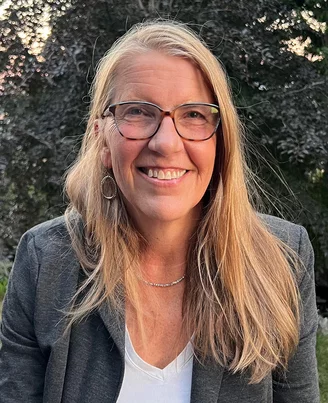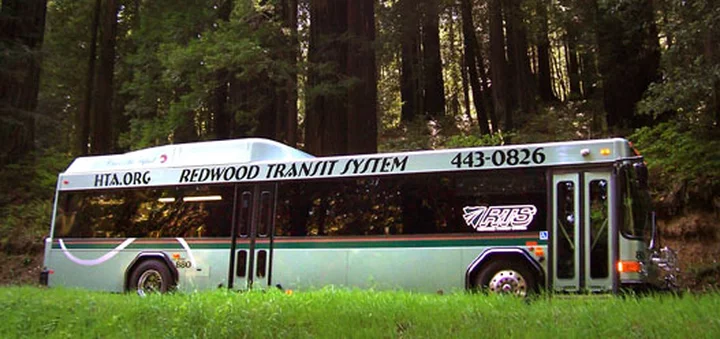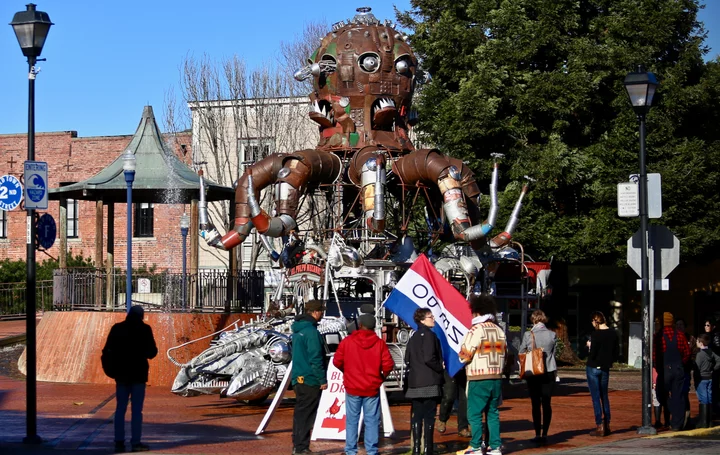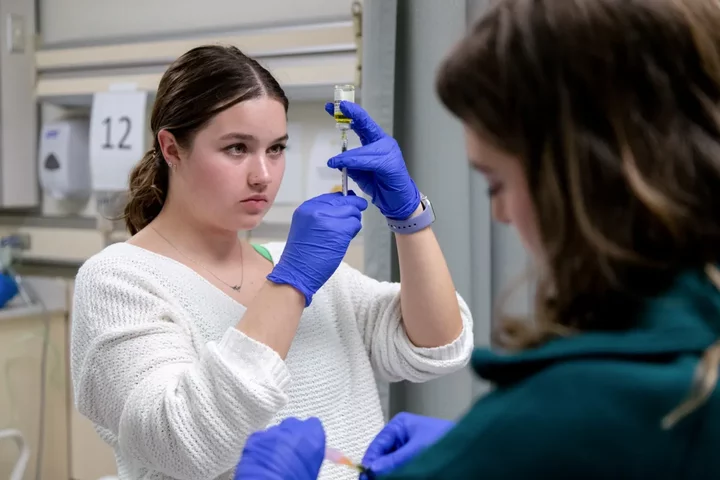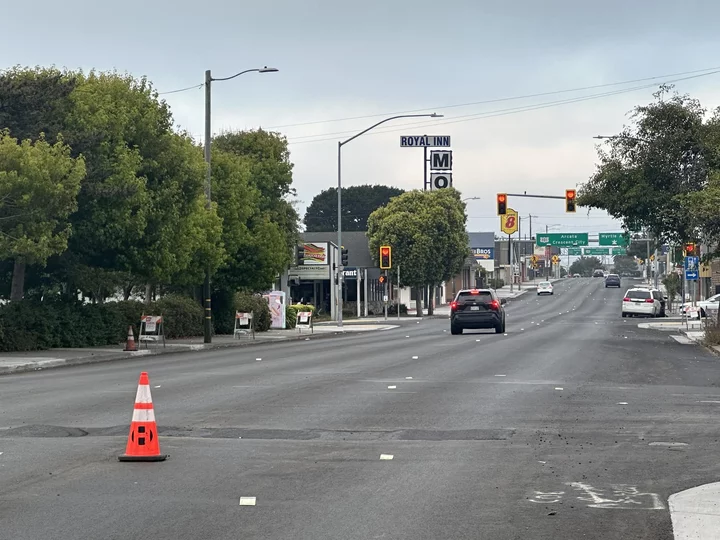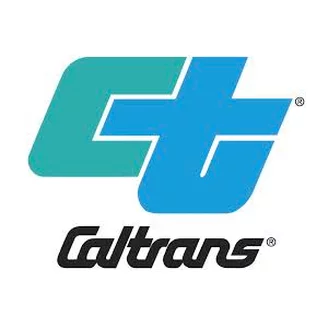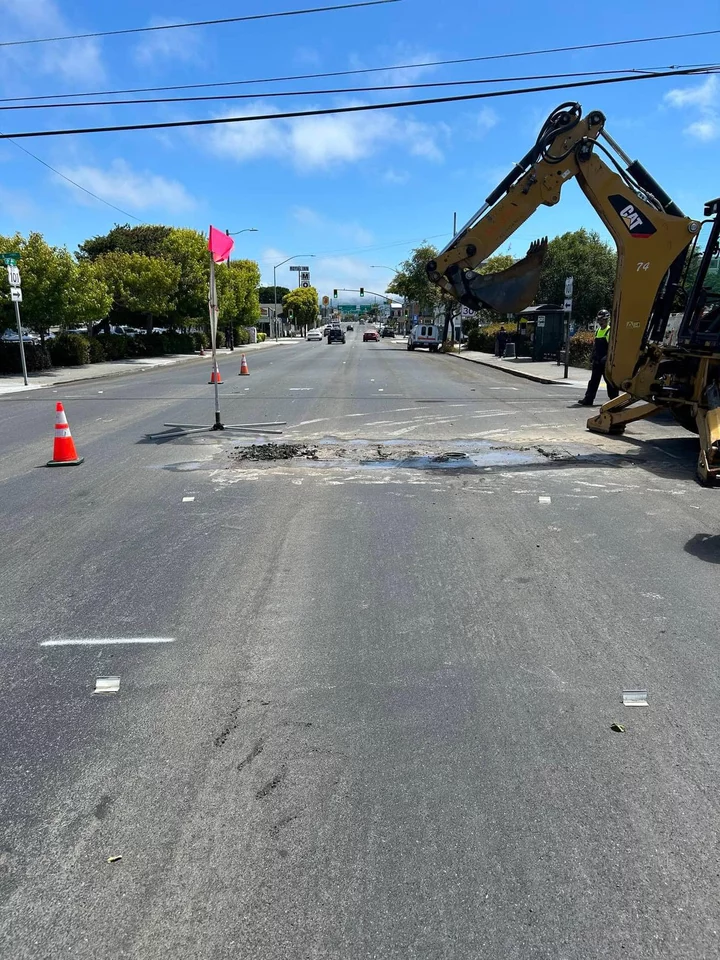STRINGS ATTACHED: Eureka Symphony Names New Maestro of Management
LoCO Staff / Tuesday, July 9, 2024 @ 3:27 p.m. / Music
Eureka Symphony release:
The Eureka Symphony’s new 2024-2025 season will present not just an exciting new lineup of musical performances and special guests, but also a new general manager.
Nancy Stephenson, a long-time local community organizer, brings 45 years of experience collaborating with Humboldt County artists, musicians, businesses, nonprofits and local government agencies. Most recently with the Redwood Coast Energy Authority for six years as their Community Strategies Manager, Stephenson also coordinated the Arcata Bay Oyster Festival and all of Arcata Main Street’s programs.
Her passion for event planning, fundraising, marketing and outreach earned her a Humboldt Heroes Award in 2006. Others know her as a goldsmith, jewelry designer, graphic artist and photographer. Her enthusiasm, diverse skills, community relationships, and willingness to accept new challenges make her a good match for the Eureka Symphony and its future.
The Board of Directors conducted an extensive search and was impressed by Nancy’s diverse skill set, history of community engagement and passion for promoting the arts,” said Board President Keenan Pool. “With Nancy’s capacity for leading an organization and Carol’s artistic vision, we could not be more excited for the future of the Eureka Symphony.”
Please reach out to Nancy if you would like to chat, have a question, or perhaps volunteer or donate.
“Listening to live symphonic music immerses us in a personal journey that’s shaped by our individual perspectives and frame of mind, but we experience it alongside hundreds of others in the audience that we don’t even know. These experiences can have a bonding effect and may bring us closer as a community - enriched, inspired, and full of hope,” said Stephenson. “I want to nourish that potential. I’m honored to be able to work with Carol Jacobson, Eureka Symphony’s Artistic Director and Conductor, the distinguished Board of Directors, the experienced and devoted staff, volunteers, donors and sponsors and of course the musicians who make this all possible. We’ll be exploring new ways to bring this local treasure to a broader audience and be a catalyst for future generations.”
Both Stephenson and Jacobson feel they have struck a chord together.
“We are so thrilled to have Nancy on board with the Symphony. I am personally looking forward to working on exciting new ideas and projects with her,” Jacobson said.The Eureka Symphony holds two major fundraising events each year. The next one, “Prelude to the Season Gala,” will take place on September 29 to kick off the 2024-2025 season. Ticket holders will enjoy the Temporary Resonance Trio (Terrie Baune, violin; John Chernoff, piano; and Carol Jacobson, cello), hors d’oeuvres by Brett Shuler Fine Catering, wine, and Claire Bent with her ukulele. Mike McGuire will host a live auction.
The Eureka Symphony, a community orchestra founded in 1991, performs five concert sets each season, with music performed by hundreds of community members, often joined by special guest artists from around the world.
For information about performances, events, tickets, or financial support, go to eurekasymphony.org.
BOOKED
Today: 4 felonies, 16 misdemeanors, 0 infractions
JUDGED
Humboldt County Superior Court Calendar: Today
CHP REPORTS
No current incidents
ELSEWHERE
RHBB: #RedFire Ignites West of Redway; Air and Ground Resources Responding
Times-Standard : Civic calendar | MMAC to discuss town center ordiance, final EIR
RHBB: Eel River Deal Trades Dam Removal for Monitored Diversion and Restoration Funds
RHBB: Fire restrictions are in effect for the Klamath National Forest
As Shelly Fire in Siskiyou County Spreads, Folks Should Prepare for Potential Smoke Impacts
Jacquelyn Opalach / Tuesday, July 9, 2024 @ 1:21 p.m. / Fire
National Weather Service screenshot.
###
PREVIOUSLY:
###
The Shelly Fire in Siskiyou County has nearly doubled in size since yesterday, spreading north and east over 6,216 acres as of this morning’s report. It is still zero percent contained.
Smoke forecasts today predict that areas in Humboldt might see air quality impacts from the fire. The government website AirNow fire and smoke map reports moderate air quality in eastern Humboldt, while a National Weather Service forecast shows smoke blowing across the county.
Reached by phone, Debra Harris, Burn Program & Wildfire Response Coordinator at the North Coast Unified Air Quality Management District, said that smoke is most likely to reach the Highway 96 corridor and nearby river drainages, based on current weather conditions and the fire’s activity and proximity.
“At this point I don’t anticipate smoke impact making it to the coast,” Harris said. The North Coast Unified Air Quality Management District is keeping a close eye on the situation and will likely issue a general info advisory soon, she added.
In the meantime, it’s not a bad idea to prepare for smoke, Harris said. She suggested designating a clean air room in your house, setting aside water and making a plan for pets.
“[It’s] always a plus when you can prepare ahead,” Harris said.
Here’s a tip sheet on how to prepare your home and your family for smoke impacts. Maybe download it! Chances are it’ll come in handy at some point this summer.
Photo via Inciweb.
Local Environment Groups Pledge to Oppose New Road Tax Unless it Includes ‘Substantial’ Funding for Public Transit
LoCO Staff / Tuesday, July 9, 2024 @ 1:11 p.m. / Transportation
File photo via Redwood Transit Authority.
Below is a statement signed by several local environmental organizations about the a proposed sales tax to support road repair, which could appear on the November ballot:
We are caught in a dilemma. Humboldt County owns and is responsible for maintaining 1,200 miles of roads. Most of these road miles are rural, providing access to a small number of residences and businesses. Taxes associated with these rural properties are not sufficient to pay to maintain the roads that reach them. Gas taxes are not enough, either. Thus, we have found ourselves a trap: We have too many roads and not enough revenue to maintain them.
The County’s solution has long been to subsidize roads using other sources of revenue, including a state funding program that should go to meeting our local unmet public transit needs — of which there are many. But none of these subsidies have been enough. Now the County is preparing another new sales tax to put toward ever-increasing road costs. You may have already received mailers from the County about this tax measure, covered with pictures of roads and natural disasters. As environmental leaders, we harbor concerns that without major changes, the new tax would be regressive and harmful to meaningful climate action.
For environmental voters, the tax measure looks like a plan to maintain an environmentally damaging status quo. Transportation is the largest emitter of greenhouse gas emissions in Humboldt County. As the draft Climate Action Plan acknowledges, reducing greenhouse gas emissions from transportation requires investing in a more balanced transportation system, and particularly increasing the use of public transit. Part of the difficulty in convincing people to take the bus is that we do not finance our transit system adequately, resulting in long wait times and poor service on the weekends and holidays. As stated earlier, the County already siphons away money from public transit to rural roads.
And despite Humboldt County’s auto-oriented transportation system, many local people don’t or can’t drive and rely on public transit instead. Many kids use public buses to get to school, seniors use transit to get to the grocery store and doctor’s appointments, and people with disabilities use transit to get to jobs and services. At least 15,000 adults in Humboldt County don’t have a driver’s license at all, and many lower-income community members lack reliable vehicle access and rely on transit for most of their transportation needs. But sales taxes hit these same low-income people the hardest. It strikes us as fundamentally unfair to ask our lower-income friends and neighbors to bear the burden of subsidizing a road system they don’t even use, primarily for the benefit of better-off residents, without getting something in return.
In short, a new sales tax that only funds roads would be both deeply inequitable and environmentally irresponsible. That’s why Humboldt’s environmental leaders will oppose the County’s tax measure unless a substantial amount of the revenue goes to support public transit.
And the County does need a substantial amount of dedicated local transit funding: we cannot be satisfied with whatever pennies may be left over after road projects are funded. For example, to serve more bus commuters–and to give existing riders the service they deserve–we need buses every 15 minutes at all stops between McKinleyville and Fortuna. That requires a commitment to meaningful local transit investment. For any tax measure to gain support from environmental voters, we insist on holistic transportation funding that meets the needs of both roads and transit.
Colin Fiske
Coalition for Responsible Transportation Priorities (CRTP)Tom Wheeler
Environmental Protection Information Center (EPIC)Melodie Meyer
Redwood Coalition for Climate and Environmental Responsibility (RCCER)Caroline Griffith
Northcoast Environmental CenterDan Chandler
350 Humboldt
Eureka Wants YOU! Do You Have What it Takes to be an Old Town Ambassador?
LoCO Staff / Tuesday, July 9, 2024 @ 11:55 a.m. / Our Culture
Can you explain this scene to tourists? You might qualify! File photo: Andrew Goff
Press release from the City of Eureka:
Uplift Eureka announces the launch of the Old Town Stewards Volunteer Program, inviting passionate individuals to join as community ambassadors in Eureka’s historic Old Town neighborhood this summer.
Modeled after successful ambassador programs in other cities, Volunteer Stewards will play a pivotal role in fostering goodwill and hospitality, offering guidance on local resources, and assisting both residents and visitors alike.
Volunteer Stewards will engage in various activities including greeting community members and visitors, providing directions and recommendations, collaborating with local businesses, and participating in beautification projects such as landscaping and litter cleanup. They will also connect residents with essential local resources and spearhead initiatives aimed at enhancing the Old Town community.
Beyond its immediate impact on Old Town, the program offers a platform for residents, businesses, community groups, and social service providers to collaborate with the city on neighborhood-level issues.
To learn more about becoming an Old Town Steward and to express interest, visit this link or contact OldTownStewards@eurekaca.gov.
California’s ‘Weak’ Job Market Propped Up by Public Money as Private Sector Sheds Jobs
Levi Sumagaysay / Tuesday, July 9, 2024 @ 7:35 a.m. / Sacramento
Nursing students Ashley Jensen, left, and Courtney Houtz practice injection procedures in the clinical skills lab at University of San Francisco in San Francisco, Calif. on Oct. 9, 2023. Health care is one of the areas that has added jobs since 2022. Photo by Amir Aziz for Calmatters.
Gains in public-sector and other jobs largely supported by public money have cloaked a dismal California labor market, which has seen a big decline of private-industry jobs since their post-pandemic peak, a new analysis shows.
The state Legislative Analyst’s Office looked at employment data from the U.S. Bureau of Labor Statistics through April, and concluded that private-sector industries in California have lost a total of 340,000 jobs since reaching their peak a couple of years ago.
The tech and finance industries led those losses. Jobs in the information sector — whose major employers include household names such as Google, Apple, Facebook and Disney — have declined 16% since their peak. There were more than 531,000 such jobs in July 2022, but 98,000 of those have gone away. Employment in the financial sector peaked at 500,000 jobs in December 2021, but it has lost 43,000 jobs, or 8%, since then.
Three other industries each saw a 3% drop in jobs since their peaks: business services, manufacturing, and transportation and warehousing. California has a 5.2% unemployment rate, the highest in the nation for the past four months.
Meanwhile, the health care and social-service industries have gained 240,000 jobs since September 2022, said Chas Alamo, principal fiscal and policy analyst for the Legislative Analyst’s Office, on Monday. Alamo said this industry includes private employers such as dentists, child care providers, vocational-rehabilitation centers and more, but is tightly linked to government spending, so his analysis groups these jobs with public-sector jobs, which have grown by 120,000 over the same period. His analysis was based on 12.5 million jobs in the private sector as of April, and a total of 5.5 million jobs about evenly split between the public and publicly supported sectors.
“The jobs picture since late 2022 has been weak,” Alamo told CalMatters, adding that state monthly jobs numbers should be “viewed with caution” because early revisions show the state did not actually add jobs last year, despite what monthly jobs reports said. Monthly jobs reports are based on surveys of businesses; revisions by federal agencies are based on states’ unemployment insurance data.
California is heavily dependent on revenue from personal income taxes, so the type of jobs that it loses or gains is important.
Brooke Armour, president of the California Center for Jobs and the Economy, said “all job growth is good.” But she added that “we’re losing high-wage jobs that help fund the (state) budget. We’re gaining hospitality and service jobs, which are low-wage jobs. We’ve hollowed out the middle-class jobs.”
The center is the information arm of the California Business Roundtable, an advocacy group that includes top executives of the state’s major employers. The group’s most recent analysis of employment data echoes Alamo’s assessment of the state’s job market. Though the center’s report mentions the group’s recurring complaints about the high costs of doing business in the state, it chalks up tech’s significant job losses mostly to the industry’s pandemic hiring sprees.
“What we’re looking at in tech jobs is a correction,” Armour said.
The center’s report said tech companies continue to prefer to remain in the tech hubs of Silicon Valley and the Bay Area. That is also important to the state’s coffers, which are becoming increasingly dependent on the stock-market performance of the tech industry.
“But while those tech companies are still here, are they growing here or are they growing elsewhere?” Armour asked. “We see a lot of them making investments outside California.”
As for whether the state’s sizable budget deficit could affect the job growth in public-sector jobs, Alamo of the Legislative Analyst’s Office said the public-sector industry also includes jobs supported by the federal government. And he said jobs in the health care and social-services industries are likely to continue to grow “despite state-budget challenges.”
###
CalMatters.org is a nonprofit, nonpartisan media venture explaining California policies and politics.
California Boosts Spending to Help Students Earn Math and Science Degrees
Li Khan / Tuesday, July 9, 2024 @ 7:34 a.m. / Sacramento
Students discuss their work in class at the MESA center at American River College on April 25, 2024. Photo by Cristian Gonzalez for CalMatters
Alina Kralya tinkers with a microcontroller for one of her computer science projects at American River College. Nearby, a group of other first-generation college students sit in green and blue chairs, chatting about their math homework. It’s a typical scene at this community college space for students in the Math, Engineering, and Science Achievement program, called MESA.
Two years ago, Kralya was in her first year at an engineering university in Ukraine when the Russian invasion and the subsequent war uprooted her family. After moving around Eastern Europe, they sought refuge in sunny Sacramento with $300 in their pockets.
Between language barriers, a brand new academic system and trying to make sense of trigonometry, it hasn’t been an easy journey for the 20-year-old, who dreams of going into robotics. When she needs tutoring or just a quiet place to study away from her younger siblings, she comes to the MESA center.
She’s still buzzing with excitement about a recent conference for female engineers she attended in San Jose. The program covered her entrance fee and transportation costs, and staff helped her set up her LinkedIn profile for the event. “Listening to all those successful ladies in STEM, oh my gosh, it was so nice,” she said.

Computer science major Alina Kralya outside the MESA center at American River College on April 25, 2024. Photo by Cristian Gonzalez for CalMatters
California allotted millions of dollars in 2022 to create the same program at community colleges across the state. Currently, 91 out of 115 campuses have programs established, with three more set to create one next year. The state hopes the expansion will reduce barriers to STEM jobs for “underserved and underrepresented” students. As the initiative rolls out statewide, questions remain about how long the funding will last, and how the programs can track how well they’re working.
To enroll in the program, students must be both low-income and a first-generation college student. The students’ parents can’t hold a bachelor’s degree in any country to meet the first-generation requirement.
Less than 1 in 5 community college students in California who want to transfer to a university succeed in doing so within four years, according to a report from the Public Policy Institute of California. For Black and Latino students, transfer pathways are even weaker: 13% for Black students and 16% for Latinos.
Beyond bolstering transfer rates, the goals for MESA include increasing representation of Blacks, Latinos, and Native Americans in STEM industries. In 2021, 9% of STEM workers nationwide were Black, while 15% were Hispanic or Latino, according to a report from the National Center for Science and Engineering Statistics.
“The community needs people to be in these positions as doctors, as scientists, as engineers, as computer scientists who actually understand the community that is being served,” said Edrina Rashidi, the officer of advocacy for the Community College Association of MESA Directors, who recently lobbied for more legislative support for the programs.


First: Barbie Schmitt chats with interim MESA project lead Samuel Morrison in the MESA center at American River College on April 25, 2024 Last: The Diane Bryant STEM Innovation Center at American River College. Photos by Cristian Gonzalez for CalMatters
Students in the program have access to a range of support, such as tutoring, academic counseling and help finding internships or scholarships. The physical centers offer computer equipment, textbooks and a place to study. Program directors work closely with students to connect them to resources.
As of fall 2023, 4,279 students were enrolled at a MESA program on their campus, according to state data.
State funds expansion of MESA programs systemwide
Four years ago, MESA programs had a $2.5 million statewide budget. After lobbying efforts from the MESA directors association, the program now has a $39.4 million statewide budget and was written into the California Education Code. Over 50 colleges have taken advantage of the funds in the last two years, nearly tripling the number of programs from 34 to 94.
Each college received a total of $428,576 for the 2022-23 school year, in the form of a grant from the state. This past year and every year through 2027 they’ll get at least $280,000 each. However, the state chancellor’s office expects colleges to eventually start covering some of the costs, so that the programs can stay afloat if the state money disappears, according to the statewide MESA project monitor Stephanie Ricks-Albert.
The state grants will be up for renewal in 2027. Rashidi said more legislation is being written that could establish a minimum funding level, to guarantee stable funding for the programs.
The program also exists in different forms across the state and nation. In California, many universities and high schools have MESA programs or clubs that are overseen by the UC Office of the President with a budget of about $7 million.
Inside a MESA program
Computers, STEM textbooks, whiteboards, a free-to-use printer and a coffee machine occupy the MESA center at American River College, housed on the first floor of the sleek new Diane Bryant STEM Innovation Center. A line of university pennants hangs from one wall; on another, three astronauts smile from a poster that reads, “FROM MESA TO NASA.”
Over 200 students have access to this space. It’s where tutors like Marco Alaniz, who is also a MESA student studying computer science, can often be found. He’s had a love for programming since his mom bought him a computer as a little kid, but he struggled when he started college the first time over 20 years ago, and ultimately dropped out.
“I just wasn’t prepared,” Alaniz said. Because his parents never went to college, they didn’t have the experience to help him navigate school or teach him time management habits. “So really, growing up, I was kind of on my own on that, just kind of figuring things out.”

Computer science major, and MESA tutor, Marco Alaniz in the Diane Bryant STEM Innovation Center, which houses the MESA center at American River College on April 25, 2024. Photo by Cristian Gonzalez for CalMatters.
After about 15 years of working odd jobs to pay the bills, Alaniz enrolled in American River College in 2019 to give his computer science degree another shot. For the past year he’s tutored MESA students. It doesn’t pay enough for him to quit his job so he can take classes full time, but he really enjoys breaking down difficult concepts for his fellow classmates, and it’s even made him consider a career in education.
Samuel Morrison, the college’s interim MESA project lead, explained that the cost of living is one the biggest challenges for the low-income students he serves. He helps connect them to scholarships and internships, as the programs are required to do. One creative way the college has found to financially assist its students is to create paid projects with faculty mentorship and research opportunities students can apply for.”
“So students are finding, OK, this is a stipend that I can use to pay for gas to get to school, or I can use to supplement food costs,” Morrison said.
Still, the college lacks a designated MESA academic counselor. Kralya, the Ukrainian student, explained that the general counselors she’s seen are not always familiar with STEM-specific transfer programs, which can differ between universities. Adding financial aid to the mix makes things even more complicated; Kralya and Alaniz both had to declare multiple majors to get certain transfer requirements covered by financial aid.
“That’s why we have to find a really good counselor who can tell us this, because this information is not listed anywhere,” Kralya said.
The state requires the programs to have designated counselors, but getting an in-house counselor can be a lengthy and complicated process, Morrison said. He hopes to have one on board by the spring of 2025.
Students can also sign up for field trips, which include conferences and college tours. Students this semester visited the Sacramento State University planetarium, attended the Women in Engineering conference in San Jose, and toured UC Berkeley and UC Santa Cruz.
At programs across the state, students who are either low-income or first-generation, but not both, can still access certain resources, such as tutoring and counseling, but can’t go on field trips or receive paid research opportunities. There are currently 1,345 of them enrolled systemwide, called ASEM students, or “Friends of MESA” at some colleges.
Growing pains as programs roll out systemwide
Two years after new funding opened the doors for more programs, many still need to hire staff, find the required minimum 500 square feet of space to house the center, or recruit students to officially get off the ground.
Just hiring a program director to lead the program can be a lengthy process. A year and a half after receiving its grant, the program at Laney College in Oakland is still without a director. The college’s dean of math and sciences, Inger Stark, appointed math instructor Kyla Oh as the program’s faculty lead for the program in the interim.
“It has definitely slowed us down,” said Stark. The bulk of the work falls on Oh, who teaches fewer credits so that she has time to focus on the program. Stark squeezes the administrative side of the program into her workday as a dean.
Right now, the state money covers the entire program, which launched in April with an initial cohort of 14 students. Stark is determined to ensure the program stays afloat through any changes in the funding, but she’s spent enough time in her community college district to have seen many “beautiful initiatives” get weeded out.
“It is heartbreaking,” she said. “A huge amount of work can fall on the ground.”
The need for more granular program data
Tracking MESA programs in a comprehensive way is not easy. Some basic data is available through public dashboards, but directors want easy access to more in-depth information about their programs to help make sure they’re meeting their goals.
“We actually have no way of measuring our success, still, with the Chancellor’s Office,” said Rashidi, the lead advocate for MESA directors.
Basic information, such as the total number of MESA students in the system, is available through the California Community Colleges Chancellor’s Office public data tool, DataMart. However, that information isn’t broken down by race, gender or major. Granular data could give program directors the ability to quickly check if their efforts to reach students from underserved backgrounds are working.
Limited information on MESA student success is publicly available. Of the MESA students who first attempted to complete a transfer-level math course in the 2021-22 school year, 79% passed within one year, compared to a 54% completion rate for the general student body, according to the Transfer-Level English and Math Completion Dashboard.
CalMatters requested MESA transfer statistics and racial data from the Chancellor’s Office. According to the data, about 62% of MESA students were Hispanic or Latino as of December 2023, while 4% were Black.
To count transfers, the Chancellor’s Office counted students who were in MESA in one school year, and then enrolled at a university the next year. By this metric, MESA programs collectively transferred 1,010 students after the 2021-22 school year, including 563 Hispanic or Latino students and 23 Black students.
Nearly half of MESA students enroll at a university within four years of taking their first community college class, as of 2017, the most recent year complete data is available. Students were considered to be MESA students if they participated in the program at any point during their first three years in the community college system.
The Chancellor’s Office will analyze the status of the programs at the end of the current grant cycle, and the results could affect how much money programs will receive in the future, according to an emailed statement from Melissa Villarin, a spokesperson for California Community Colleges. Any additional funding would be based on “program and campus metrics,” according to the statement.
###
Khan is a fellow with the College Journalism Network, a collaboration between CalMatters and student journalists from across California. CalMatters higher education coverage is supported by a grant from the College Futures Foundation.
CalMatters.org is a nonprofit, nonpartisan media venture explaining California policies and politics.
Your Morning Commute Through Eureka Could Be Slowed This Morning
LoCO Staff / Tuesday, July 9, 2024 @ 7:06 a.m. / Traffic
Caltrans
Caltrans release:
Attention U.S. 101 travelers in Eureka:
Starting Tuesday at 5 a.m., northbound 101/Fifth Street in Eureka will be reduced to one lane at K Street for emergency repairs. All three lanes are expected to be reopened by noon. This closure is unrelated to the ongoing ADA improvement project in the area. Motorists are asked to drive with caution and use alternate routes if possible.

